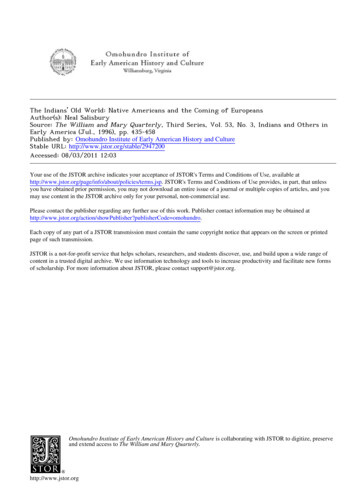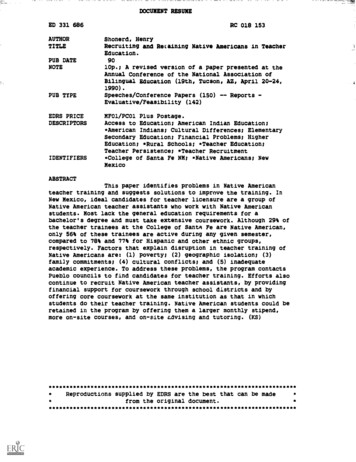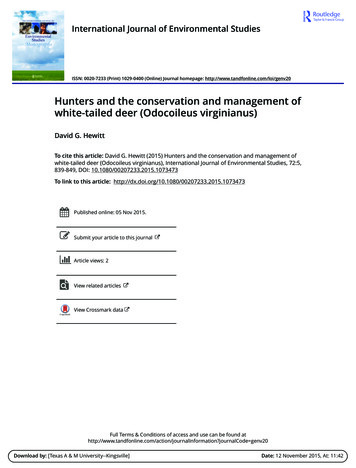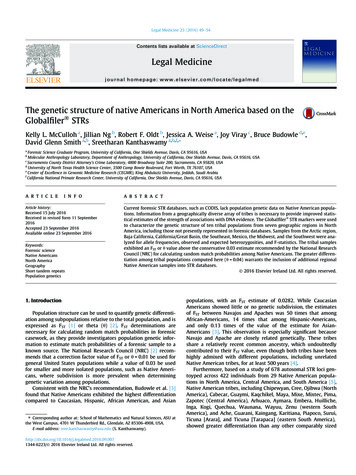
Transcription
The Native Americansof the San Ramon ValleyFOCUS:To understand the local Indian culture and the Indians’dependence on the environment of our valley.MAIN IDEA:Read to understand how our local Indians survived inour valley by using everything that grew here pter 4acornmortarpestleleachingspearsIndians of the San Ramon Valley 1
Student pagesA Morning Many, Many Years AgoThe young Tatcan boy forced himself awake. It was so warm and cozy lyingunder the animal skins. Even the tule mat he slept on was comfortable. He didn’twant to leave his bed, but he had chores to do. He lifted the deerskin that coveredthe opening of his family’s domed shelter and felt the rush of the chilly morningair. He peered outside.Already his mother and sister were pounding dried acorns. The women saton the large rock mortar. This would make the acorn into flour after his motherleached the flour with the fresh water from the creek near the camp. This cleaned,mushy flour would often be cooked as hot cereal. He was hungry and this wouldbe breakfast.The boy could hear the thump, thump, thump of their rock pestles as theypounded the acorns into flour. He knew that his mother would leach the flourwith fresh water from the nearby creek and then would cook the sweet flour in aspecial cooking basket. The thought of the warm acorn mush made the boy’smouth water. He was hungry.Chapter 4Indians of the San Ramon Valley 2
The boy picked up the gathering basket hissister had woven from young willow branches. Hewalked to a patch of blackberry bushes at the farend of the village. As he picked berries forbreakfast, he could see his father and other menfrom the tribe preparing for a deer hunt. Thehunters gathered their handmade spears. Theyrubbed their bodies with bay leaves to ridthemselves of human scent. Then, one, by one, they walked into the rolling hills tohunt. The boy dreamed of the day when he would be among the hunters.Someday soon The First PeopleIndians were the first people in our valley. No one knows exactly how theyarrived here or where they came from, but they lived here as long as 5,000 yearsago. Many different tribes lived in and around the San Ramon Valley. Theydepended on the plants and trees that grew hereand the animals that roamed our hills and valley.Understanding the San Ramon Valleyenvironment is important in understanding Indianlife.The Tatcan tribe (Bay Miwok speakers)lived on the valley floor where Danville andAlamo are now located. The Seunen tribe(Costanoan/Ohlone speakers) lived in San Ramonand Dublin. The names Tatcan and Seunen weregiven to the Indians by the Spanish. Each tribehad from 50 to 250 people. Even though theyeach spoke a different language, the Indians traded with one another for things thatwere needed for everyday life and visited each other for celebrations.The EnvironmentThe San Ramon Valley was rich in natural resources and the weather wasmild. The Indians hunted, trapped, fished, and gathered the foods that grew herenaturally. They burned fields to promote seed growth for young plants which deerand elk liked to eat. The Indians lived outdoors on the creek banks and nearChapter 4Indians of the San Ramon Valley 3
springs. Water was needed, so they built their homes and shelters close to watersupplies.The women did most of the gathering, storing and preparation of the food.They gathered seeds and acorns, each in its own season. There were many oaktrees that grew in the valley. The Indian used the acorns from these trees as animportant source of food. They gathered the acorns in the fall and dried themduring the winter.After removing the shell, the women pounded the acorns on a large rockwith a hole, called a mortar. They used a stone pestle to pound the nut into flour.Acorns have a bitter taste, so the women always leached the acorn flour withwater. One way they washed away the bitter taste was to put the flour into a basketlined with leaves and pour water over the flour several times. This is called“leaching”.After leaching, the flour tasted sweet. The wet flour was put into a closelywoven basket with water. Hot stones were dropped into the basket to cook theacorn mush which could be eaten as hot cereal. Sometimes pancakes were madewith the flour and fried on a hot stone from the campfire. Other times the womenmade bread by wrapping the acorn mush in leaves and baking it in the fire.The Indians made baskets out of young branches or grasses which theygathered in certain seasons. Baskets had many purposes. They were used asbowls, cooking utensils, storage, seed-beaters and hats.The Indians ate the meat of the many animals and fish found here in thevalley. Deer and antelope were good to eat. Smaller animals such as rabbits,squirrels and other small creatures were also trapped for food. The men trappedbirds or fish by weaving vines into nets or baskets.The Indian men were responsible for hunting. One way they killed a deerwas by forming a wide circle around it. They would make loud noises whilewalking closer to the deer in the center of the circle. Eventually the deer would betrapped with no way out of the circle and the men used their spears to kill it.Chapter 4Indians of the San Ramon Valley 4
Sometimes the Indians would disguise themselves by wearing a deer head asa mask. They would prowl slowly into the middle of a herd of deer and then spearone. The human scent was disguised by rubbing bay leaves on their bodies. Boysfirst learned to hunt small animals.The Indians used short spears or bow and arrows. The bows were made outof certain types of wood and tied with animal tendons. The arrows were made fromstraightened branches topped with a pointed arrowhead at the end. They oftentraded for volcanic rock (obsidian) from which they made the arrowheads. Ifobsidian was not available, they used chert, a softer rock, found on Mt. Diablo.The Indian CultureThe Indians of our valley were strong people with dark hair. They woretheir hair long, often dressing it with small shells, beads and strips of rawhide.They wore few clothes in good weather.The women of the tribes worked very hard.They did the cooking, gathering, and basketweaving and were in charge of raising thechildren. The men hunted and fished. The wholetribe worked together to gather acorns in the fall.For shelters, the Indians selected and bentlong willow branches to make a dome-shapedframe. They then tied bundles of grass or tulewith snugly onto this frame. Tule is a strong plantwith a straight stem that grows in creeks. Anopening was left in the roof for smoke to escapeand an opening was left in the front for a smalldoor. The shelter was warm and dry inside.Chapter 4Indians of the San Ramon Valley 5
The women made skirts or aprons from deerskins or from softened tree bark.They tied the skirts around their waists with a vine. During the cold weather, thepeople wore deer, rabbit or otter skins to keep themselves warm. They wove stripsof rabbit skins together to make robes or blankets.The Indians loved to sing songs, dance, and tell tribal stories or histories.These songs, dances, and stories were taught to the children of each generation.The Indians would decorate their bodies with feathers, paint or shells for specialceremonies, such as harvest or acorn celebrations. Tribes would gather at specialtimes to trade, visit friends and relatives, dance, sing and share old and new stories.Different tribes would trade shells, salt, furs, baskets, special plants or acorns witheach other.Kathie Petrie, 2004Chapter 4Indians of the San Ramon Valley 6
Teacher PagesStudent Activities Critical ThinkingWhy do you think the Tatcan and Seunen Indians chose to live in our valley? Why werenatural resources important to the Indians? Show What You KnowArt ActivityDraw a picture showing as many details as you can about the Tatcan or Seunen way oflife. Share this with a partner explaining what you drew.Art ActivitySelect something that would be a symbol of the way our Indians lived. Draw a picture ofit. Explain why this would be a symbol for the Tatcan or Seunen Indians.Poster ActivityCreate a poster that would teach another person about our valley Indians. Teach anotherthird grader about the valley Indians.Field Trips (See special section on field trips.) Family field trips: Oakland Museum, Coyote Hills Regional Park, Sunol RegionalPreserve Passport Opportunity: Go to Hap Magee Ranch Park and visit the Tatcan IndianCommemorative Site just west of the dog parkHistory/Social Science Standards 3.a Develops and demonstrates respect for the uniqueness of individuals and theirdifferences.3.2 Describes the American Indian nations in their local region long ago and in the recentpast.Chapter 4Indians of the San Ramon Valley 7
Reading and Social StudiesPasquala, the Story of a California Indian Girl, by Gail Faber and Michele LasagnaAdditional ResourcesMapsEssaysThey Came First Information from the Museum of the SRVFirst People of the East Bay by Beverly OrtizMount Diablo and Native Peoples by Beverly OrtizWebsites Bay Miwok Indians: cccoe.net/miwokproject (For third grades by Maria Forester)Ohlone Indians: wccusd.k12.ca.us/ohlone/village, coyote press.org, native cc.comCaliforniahistory.net/span: California Indianswww.valleysentinel.com/archivesSept., Oct. 2003www.nativeculture.com/lisamitten/indians.html - click on Information on Individual NativeNationswww.ci.danville.ca.us/ - Town of Danville website – link to our community, about Danville,Indians of the San Ramon Valleywww.ci.san-ramon.ca.us/srhistory/history.htm - City of San Ramon website – linkSUBJECT SEARCH TERMS FOR LIBRARY CATALOGUE:Many items can be found simply by using the tribe as the search term (e.g. Ohlone) Indians of North America CaliforniaLocal history Contra Costa CountyBooks:INDIANS OF THE SAN RAMON VALLEY AND HOW THEY LIVED 970.3 MARGOLIN - The Ohlone way: Indian life in the San Francisco-Monterey Bay area 970.49463 BOHAKEL – The Indians of Contra Costa County RJ973.0497 – U.X.L. encyclopedia of Native American Tribes J973.04974 COVERT - Coast Miwok 979.4 FAGAN- Before California – an archeologist looks at our earliest inhabitants J979.4004 – California Indian Flash CardsChapter 4Indians of the San Ramon Valley 8
979.46004 OHLONE - The Ohlone past and presentRJ979.40049 BOULE – California Native American TribesJ979.40049 BOULE – Foothill Yukot TribeJ979.40049 BOULE - Ohlone tribeJ979.40049 BOULE – Patwin TribeJ979.40049 BOULE – Valley Yukot TribeJ979.40049 GRAY-KANATIIOSH - Miwok979.40049 INDIANS - Indians of the San Ramon ValleyJ979.40049 INDIANS – Indians of the San Ramon ValleyR979.40049 VANE – California Indians: Primary resourcesJ979.40049 WILLIAMS-The Ohlone of CaliforniaJ979.46 MORROW (Ohlone) - Pre-Americans at play in Contra Costa County979.463 FREED (Ohlone) - People at the edge of the world979.461 EXPLORATION - An explanation of our history (East Contra Costa County) videolinksRandall Milliken, A Time of Little Choice, The Disintegration of Tribal Culture in the SanFrancisco Bay Area, 1769-1810 (Menlo Park: Ballena Press), 1995.Beverly W. Lane, ed., The Bay Miwok, First People of Contra Costa County, READINGS(Martinez: Contra Costa County Historical Society), 2003.Chapter 4Indians of the San Ramon Valley 9
They Came FirstThe Indians of the San Ramon ValleyFor untold centuries people have lived in the San Ramon Valley. They built their homes bythe creeks, hunted in the valley and worshipped in sacred places and on the Mountain.Living in village communities of 50 to 200 people, the rhythm of their lives was determinedby the cadence of the seasons. The San Ramon Valley environment was rich with a varietyof foods, including acorns, seeds, birds, deer and fish. Regular meetings with other tribestook place, including trading encounters, autumn festivals on Mount Diablo and perhapstravel to the Bay.In 1772 westerners first came through the San Ramon Valley. Spanish missionary priestsrecorded the names by which the Indians were known to their neighbors: Tatcan andSeunen. The Tatcans were part of the Bay Miwok linguistic group, were closely related tothe Saclans and probably lived in the Alamo-Danville area on San Ramon Creek. TheSeunens were Costanoan (Ohlone) speakers who lived in the San Ramon-Dublin areaaround the South San Ramon and Alamo Creeks.After 1794 the Indians began moving to the Spanish missions, first to San Francisco andthen to San Jose. The foreign weapons and unusual gifts intrigued them and many chose toally themselves with the powerful Europeans. Once baptized they could no longer leave themission at will.Ultimately the Spanish ideas, diseases and grazing animals destroyed the Valley Indians’way of life. Today the Tatcan and Seunen tribes of the San Ramon Valley are no more,although descendants of Bay Miwok and Ohlone tribes do live among us today. Theartifacts unearthed next to springs and creeks and the bedrock mortar holes on Mount Diabloremind us that a culture of great antiquity existed in the San Ramon Valley just 250 yearsago.Information from an exhibit in the Museum of the San Ramon Valley205 Railroad Ave. (in the restored Danville depot)925-837-3750 museumsrv.orgOpen hours: 1-4 Tu-Fri, 10-1 SatVisit the museum to learn more about the valley’s first residents.Chapter 4Indians of the San Ramon Valley 10
Mount Diablo and Native PeoplesMount Diablo had profound significance for many Native California groups within its expansiveview. The Julpun of the area now known as Brentwood and Byron recognized the mountain asthe birthplace of the world. Hundred of miles away in the Sierra, some Northern Miwok saw itas the place from which a supernatural being lit a previously dark landscape. Further south in theSierra, the Central Miwok featured the mountain as part of one of their most sacred ceremonies.Wintun elder Frances McDaniel said that Wintun spiritual leaders prayed to the creator from themountain’s heights.Chochenyo speakers form the Mission San Jose area called the mountain Tuyshtak, meaning “atthe day.” The Nisenan of the Sacramento Valley called it Sukkujaman, or, as Nisenan elderDalbert Castro once explained, “the place where dogs came from in trade.”Most of Mount Diablo, including its peak, was within the homeland of the Volvon, a Bay Miwokspeaking group, and as early at 1811 the mountain was called Cerro Alto de los Bolbones (HighPoint of the Volvon). Originally, Monte del Diablo (Devil’s Thicket) was the name given to awillow thicket near present-day Concord where, in 1805, the Chupcan made a daring nighttimeescape from a Spanish military expedition headed by Luis Arguello. Folklore relayed to theState Legislature by Mariano Vallejo in 1850 mistakenly located the incident at the mountain.About 25 independent tribal groups with well-defined territories lived in the surrounding EastBay countryside. Their members spoke dialects of three distinct languages: Ohlone, Bay Miwokand Northern Valley Yokuts. Each tribe’s leadership and culture varied and each had three orfour village sites, with populations numbering about 40 to 200.Today, the mountain remains an important and meaningful place for many Native peoples,including those who live locally. As Pomo elder and doctor Mabel McKay said in 1985, “Iwould listen as Jim [Cooper, an herb doctor who was born in the Diablo area] told mygrandmother about how sacred Mount Diablo is. He said that as long as the mount stands it willbe a sacred mountain.”Author Beverly R. Ortiz is writing a book about the significance of Mount Diablo to California Indians.Basket photo art by Louis Choris (c. 1816), courtesy Bancroft Library.Chapter 4Indians of the San Ramon Valley 11
First People of the East BayBy Beverly R. OrtizAt the dawn of time, Oj.ompil.e (now called Mount Diablo) was the sacred birthplaceof the world. Supernatural beings, the First People, the people before Indian people, livedhere. The First People are often designated with the names of animals whose attributesare reflected in their personalities – Condor, Prairie Falcon, Eagle and Coyote. The FirstPeople made Indians, providing them with a bountiful, beautiful world, a world which onlytwo centuries ago was much different from the world today. A world in which condorsstill flew, a reminder of the sacred time.In the late 1700s, it’s estimated that between 280,000 and 340,000 people lived inwhat is now California. They spoke about 100 distinct languages. Three such languageswere spoken in the East Bay: Bay Miwok, Ohlone/Costanoan and Northern Valley Yokuts.The people were organized into small, independent nations of from one to fivetowns (villages) including a capital. Six such nations spoke the Bay Miwok language – theChupcan of present-day Concord, the Julpun of Oakley-Brentwood, the Ompin of Pittsburg,the Saclan of Lafayette, the Tatcan of Danville and the Volvon of upper Marsh Creek.Towns had anywhere from 40 to 160 people. They lived in houses constructed of willowframes, thatched with tule or native bunchgrasses.Many items, such as tools, beads and baskets were an integral part of daily life, andthese required precision, patience and technical ability to make. Specialists andprofessionals often served economic and ritual roles.Hunting and gathering activities required in-depth knowledge of natural cycles.Plant resources were cultivated for optimum harvest with horticultural techniques, such aspruning and burning.At various times, neighboring groups gathered for Big Times, events which featuredceremonial feasting and dancing of several days’ duration. Social bonds were renewed andstrengthened, news was shared and goods were traded. Some trade items went throughseveral groups before arriving locally. Obsidian for arrow points came from Napa, whilebows appear to have been imported from the Sierra.Disputes were mediated by community leaders, spiritual leaders and familymembers. Spiritual balance was maintained through complex religious practices. Elegantlydesigned and carefully constructed featherwork was worn on ceremonial occasions. Danceserved as a visible prayer. It was, and throughout California still is, performed to insurethe health and well-being of the group.The world changed dramatically after the Spanish began to encroach on the EastBay in 1772. The panic and startled shouting with which the Tatcan living in the SanRamon Valley greeted the Spanish signaled what was to come.Chapter 4Indians of the San Ramon Valley 12
The Spanish invasion culminated in the establishment of a mission and presidio(fort) at San Francisco in 1776. While some East Bay people were attracted to themissions, once there they were not allowed to leave without permission of the priests.Many people resisted missionization. The Huchiun (Ohlone from present-day Richmond),Saclan, Volvon and Chupcan were among the groups whose members led the resistance.Their resistance efforts were partly responsible for the decision to locate Mission SanJose so near to Mission Santa Clara in 1797.Diseases of European origin killed large numbers of people at the crowded,unsanitary missions. Spanish military expeditions killed others.By the time the missions closed in 1836, the local Native peoples had been reducedto serfs on the land they loved and cared for all those thousands of years. These landshad become large Spanish and Mexican ranchos. The destruction of the old way of life wascompleted during the early years of American settlement. As Contra Costa County settlerJohn Marsh wrote in 1846: “ without the (Indians) the business of the country couldhardly be carried on.” Indian kidnapping and slavery is part of the legacy of EuroAmerican settlement. A statement by John Monroe Walker, who owned a ranch on MountDiablo, sums up the treatment of Indians during this time: “When one bought a ranch hebought the Indians that went with the property.”Despite the tremendous pressure against it, people continued their culturaltraditions after missionization. A multi-ethnic community of former Mission San Joseresidents and their descendants existed near Pleasanton into the 1930s. Composedprimarily of Ohlone /Costanoan, Plains Miwok, Northern Valley Yokuts, Patwin and CoastMiwok peoples, Alisal (the Pleasanton rancheria) was a center of traditional religiouspractices.Today, many California Indians have retained their cultural values, traditions andhistory, while living within the framework of contemporary society. Descendants of theBay Area’s first peoples are involved in protecting ancestral village and sacred sites,participating in Big Times, creating traditional objects, and interpreting their culturalhistory to the public.Beverly Ortiz is a staff naturalist with the East Bay Regional Park District. This article originallyappeared in Parkland Discoveries, 1990, a guide to the natural and cultural resources of East BayRegional Park District. It was updated in 2003. For further information, call 510-635-0135.Chapter 4Indians of the San Ramon Valley 13
A map of the tribal locations of Indians in the Bay Area. James BennyhoffChapter 4Indians of the San Ramon Valley 14
Chapter 4Indians of the San Ramon Valley 15
Chapter 4Indians of the San Ramon Valley 16
Photo art by Louis Choris (c. 1816), courtesy Bancroft Library.Chapter 4Indians of the San Ramon Valley 17
The San Ramon Valley was rich in natural resources and the weather was mild. The Indians hunted, trapped, fished, and gathered the foods that grew here naturally. They burned fields to promote seed growth for young plants which deer and elk liked to eat. The Indians lived outdoors on the creek banks and near











